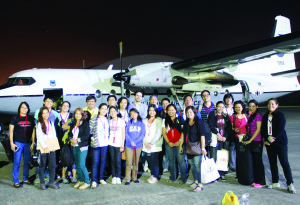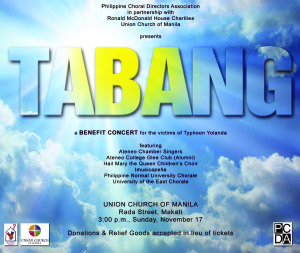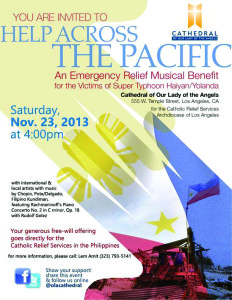Les chorales se mobilisent à travers le monde pour l'aide humanitaire
Par Jonathan Velasco, chef de chœur, Président du PCDA
L’année dernière, les Philippines ont dépassé leur quota de catastrophes naturelles. Le 15 octobre, un puissant tremblement de terre de magnitude 7,2 a secoué les îles de Bohol et Cebu, tuant plus de 200 personnes et détruisant bâtiments et églises datant de l’arrivée du christianisme dans le pays, au XVIIe siècle. Parmi elles, l’église Loboc, où le Chœur des Enfants de Loboc, anciennement récompensé, avait résidence. Le chœur s’en est sorti indemne, mais son église est en ruines. À peine trois semaines plus tard, c’est le typhon qui est arrivé.
Début novembre, le chef de chœur de Manille Joel Aquino préparait son chœur d’enfants STEFTI en vue du concours choral national qui se tiendrait à Manille à la fin du mois. Le chœur était basé à Tacloban City et Joel les rejoignait par avion à chaque répétition. Les enjeux étaient importants : le chœur faisait partie des six seuls chœurs d’enfants qualifiés pour chanter au concours national.
Le 8 Novembre 2013, le typhon Haiyan a provoqué des glissements de terrain à Guiuan, à l’est de Samar, aux Philippines. Ce fut la tempête la plus forte jamais enregistrée en termes de vitesse du vent. Le typhon s’est accompagné d’une trombe d’eau de 5 à 6 mètres de haut, emportant sur son passage les frêles maisons de la côte, les voitures et camions réduits à de simples jouets, et projetant sur la côte les énormes navires de commerce. Le typhon est passé par la ville très peuplée de Tacloban avant de faire ce que le New York Times a appelé “une forme mortelle de marelle”, provoquant cinq autres glissements de terrain sur les îles centrales (dont Cebu) avant de quitter enfin les Philippines.
Les désastres ont été monumentaux, avec des villes entières effacées de la carte et des cocotiers déracinés par milliers de colline en colline. 6 201 personnes sont mortes, et des milliers d’autres sont portées disparues. Les dommages portés à l’agriculture et à l’infrastructure représentent environ 880 millions de dollars américains. Les rescapés, qui se sont enfuis avec uniquement ce qu’ils portaient sur eux, ont rapidement été confrontés à une crise humanitaire sévère, sans aide immédiate, ni nourriture et eau, ni police pour rétablir l’ordre et le calme. Les morts jonchaient les rues, sans que personne ne les enterre.
Après plusieurs jours de paralysie suite aux pannes des moyens de communication, aux routes impraticables et à l’aéroport détruit, le monde s’est remis en action. L’aide est immédiatement arrivée en masse des quatre coins du globe. Émus par les images diffusées à la télévision, plusieurs institutions gouvernementales et non-gouvernementales ont rapidement envoyé de l’argent, des bateaux, des biens de première nécessité, du personnel médical, des tentes, des housses mortuaires, des avions et des sauveteurs. Les Philippins de l’étranger ont grandement participé aux efforts humanitaires en organisant des événements et en contribuant de leur propre poche.
Le monde choral n’est pas resté les bras ballants. La Philippine Choral Directors Association (PCDA) (Association des Chefs de Chœurs philippins) a lancé une série de concerts les fins de semaines des mois de novembre et décembre, lors desquels les produits de première nécessité et les dons remplaçaient les tickets d’entrée habituels. Les ramifications provinciales du PCDA se sont également mobilisées en organisant des concerts de charité dans les églises et les centres commerciaux. De nombreux chœurs ont rejoint le mouvement, notamment dans les grandes villes que sont le Grand Manille, le Grand Cebu et le Grand Davao. La célébration de la Journée chorale mondiale a été intimement liée à la collecte de fonds dans ces villes.
La Fédération Internationale de Musique Chorale (FIMC) a encouragé ses membres à fêter la Journée mondiale du chant choral de décembre dernier en participant, d’une manière ou d’une autre, à l’aide humanitaire dédiée à la situation aux Philippines. L’Association chorale européenne – Europa Cantat a, quant à elle, sensibilisé ses membres aux efforts humanitaires en leur suggérant de faire un don à la Croix-Rouge nationale philippine.
Des chœurs comme le Philomela et le Grex Musicus, tout deux dirigés par Marjukka, ont donné le 17 décembre 2013 un concert dont les bénéfices ont été versés aux aides humanitaires. Le chœur du Conservatoire de Musique de Nagaland, en Inde, a quant à lui organisé le 4 décembre un concert de charité intitulé “Paraiso”. Aux États-Unis, les américo-philippins ont rassemblé leurs efforts pour mettre sur pied des concerts, notamment sur la Côte Ouest, où de nombreux Philippins résident. Le Chœur de Jeunes de Nouvelle-Zélande, qui était alors en tournée aux Etats-Unis, a pu chanter à un concert donné le 17 novembre à la cathédrale Our Lady of the Angels à Los Angeles, en Californie. Trois chœurs philippins de Singapour, menés par le Chœur PsalmiDeo, ont chanté au concert “Songs of Hope” (Chants d’espoir) à Singapour. L’ensemble SYC, Chanteurs de Singapour, ont dédié leur concert d’anniversaire aux victimes du typhon en chantant des chants de Noël philippins.
Les chœurs du monde entier se sont rassemblés en chantant, dirigeant leurs voix et leurs pensées vers la ville de Tacloban et vers les autres villes touchées par le typhon Haiyan. Finalement, Joel Aquino a retrouvé, petit à petit, chacun des enfants membres du chœur. Malheureusement, le chœur n’existe plus: les enfants se sont éparpillés dans tout le pays, ayant rejoint des amis ou leurs proches, pendant que leur chère ville se bat pour se reconstruire. Avec l’aide de l’humanité, avec les chœurs chantant à l’unisson, les habitants de ces îles ont pu reprendre une vie décente.
Jonathan Velasco est chef de chœur, pédagogue et juge aujourd’hui très sollicité. Il a étudié à l’Université du Collège de Musique philippin et à la Kirchenmusikschule de Berlin. Il fut membre et chef assistant du Chœur mondial des Jeunes, et en 1996 il en est devenu le premier chef asiatique. Velasco tient régulièrement des ateliers de chorale aux Philippines et à travers le monde. Il est membre du jury de nombreux concours de chœurs en Europe et en Asie. Il dirige actuellement le Chœur de Chambre d’Ateneo. Velasco est conseiller à la direction de la FIMC, et est le représentant philippin au World Choir Council (Comité Choral International). En 2008, il a été élu premier président de la nouvelle Association Philippine Choral Directors Association (Association des Chefs de Chœurs philippins). Email: choirmaster@gmail.com
Traduit de l’anglais par Anne-Laure Pitici (France/Brésil)


